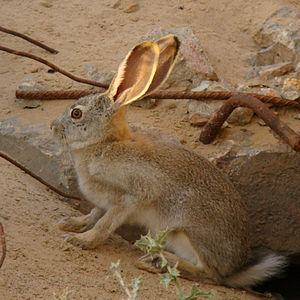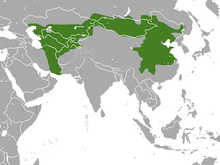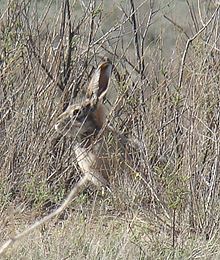Tolai hare
| Tolai hare | ||||||||||||
|---|---|---|---|---|---|---|---|---|---|---|---|---|

Young Tolai Hare ( Lepus tolai ) |
||||||||||||
| Systematics | ||||||||||||
|
||||||||||||
| Scientific name | ||||||||||||
| Lepus tolai | ||||||||||||
| Pallas , 1778 |
The Tolai hare ( Lepus tolai ) is a species of mammal belonging to the genus of the real hare ( Lepus ) within the hare-like (Lagomorpha). Its distribution area covers large parts of Asia from the Caspian Sea to far into the People's Republic of China.
features
The Tolai hare is a hare with a head trunk length of 40 to 59 centimeters and the weight is 1650 to 2650 grams. The hind feet are 110 to 127 millimeters long, the ears 83 to 120 millimeters and the tail 72 to 110 millimeters. The coloration varies very clearly in the entire distribution area and also within parts of it. The colors of the back fur vary from sand yellow to light brown, dark yellow, gray and dark brown and can have red-brown stripes. The hips can also be ocher or gray. The tail corresponds to the body color and has a broad dark to black-brown stripe on the top. The ventral side and parts of the sides are white. The eyes have a gray-white border that can also be ocher in the southern part of China; this extends back to the base of the ears and forward to the muzzle. The tips of the ears are black.
The skull has relatively long and wide nasal bones , while the rostrum is short and wide. The supraorbital process , an extension of the frontal bone above the eyes, is well developed, almost triangular and largely flat. The tympanic membrane is large and round.
distribution
The Tolai hare is distributed over the arid regions of Asia and extends quite far south in East Asia. Its distribution area extends from the Caspian Sea to the south to northern Iran and to the east via Uzbekistan , Turkmenistan , Afghanistan , Kazakhstan , southern Siberia and Mongolia as far as the People's Republic of China .
The species occurs in Mongolia at heights of up to 8,000 meters, but in the Chinese part of the range it is usually found between 600 and 900 meters in height.
Way of life
The Tolai Hare's habitat is very diverse. In Mongolia it is found mainly in semi-deserts , mountain and forest steppes as well as in mountainous and stony habitats. In China it mainly populates grasslands and forest meadows, but hardly the interior of forest areas. He prefers habitats with hiding places such as tall grass and bushes.
The Tolai hare is nocturnal and feeds primarily on grasses , roots and herbs. Except for the throws, he does not dig any structures, but only shallow hollows with the help of his front legs. The Sassen are flatter in warm weather and significantly deeper in cold weather and wind. The animals rest motionless in these hollows and only flee when threatened.
The species reproduces two to three times a year within a seven-month reproductive period, with each litter consisting of two to six young.
Systematics
The Tolai hare is assigned to the real hare (genus Lepus ) and as an independent species . Until recently it was considered a subspecies of the brown hare ( Lepus europaeus ) or the kaphase ( Lepus capensis ). The hare Lepus tibetanus , which is now also considered a species in its own right, was originally listed as a subspecies, as was L. o. Przewalskii , which is now considered a subspecies of the Tibetan woolly hare ( Lepus oiostolus ) .
In addition to the nominate form L. t. tolai seven further subspecies distinguished: Lepus tolai aurigineus , L. t. buchariensis , L. t. cheybani , L. t. cinnamomeus , L. t. filcheri , L. t. lehmanni and L. t. swinhoei . The assignment to subordinates varies in part, so Smith & Yan Xie list six subspecies in China in 2009 alone and name besides Lepus tolai aurigineus , L. t. cinnamomeus , L. t. lehmanni , L. t. swinhoei and L. t. tolai the subspecies L. t, not known to Wilson & Reeder 2005 . hunagshuiensis . L. t. swinhoei was also considered a separate species based on molecular analyzes.
Hazard and protection
The species is classified as “least concern” by the International Union for Conservation of Nature and Natural Resources (IUCN) due to its large distribution area and high population numbers. No major threats to the species population are known, but no current data is available either.
supporting documents
- ↑ a b c d e f g h i Tolai Hare. In: Andrew T. Smith , Yan Xie: A Guide to the Mammals of China. Princeton University Press, 2008; Pp. 291-292. ISBN 978-0-691-09984-2 .
- ↑ a b c d e f Lepus tolai in the IUCN Red List of Threatened Species 2012.1. Posted by: Andrew T. Smith , AF Boyer (Lagomorph Red List Authority), 2008. Retrieved November 7, 2012.
- ↑ Distribution area according to IUCN
- ↑ a b Joseph A. Chapman, John EC Flux (Ed.): Rabbits, Hares and Pikas. Status Survey and Conservation Action Plan. (PDF; 11.3 MB) International Union for Conservation of Nature and Natural Resources (IUCN), Gland 1990; P. 72f. (under Lepus capensis ). ISBN 2-8317-0019-1 .
- ↑ a b Don E. Wilson & DeeAnn M. Reeder (eds.): Lepus tolai ( page no longer available , search in web archives ) Info: The link was automatically marked as defective. Please check the link according to the instructions and then remove this notice. in Mammal Species of the World. A Taxonomic and Geographic Reference (3rd ed).
literature
- Tolai Hare. In: Andrew T. Smith , Yan Xie: A Guide to the Mammals of China. Princeton University Press, 2008; Pp. 291-292. ISBN 978-0-691-09984-2 .
Web links
- Lepus tolai inthe IUCN 2012 Red List of Threatened Species . Posted by: Andrew T. Smith , AF Boyer (Lagomorph Red List Authority), 2008. Retrieved November 7, 2012.


